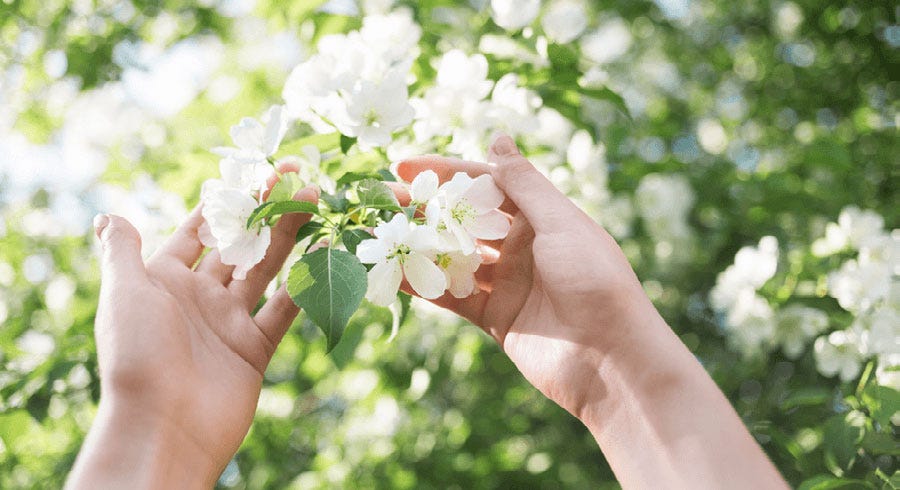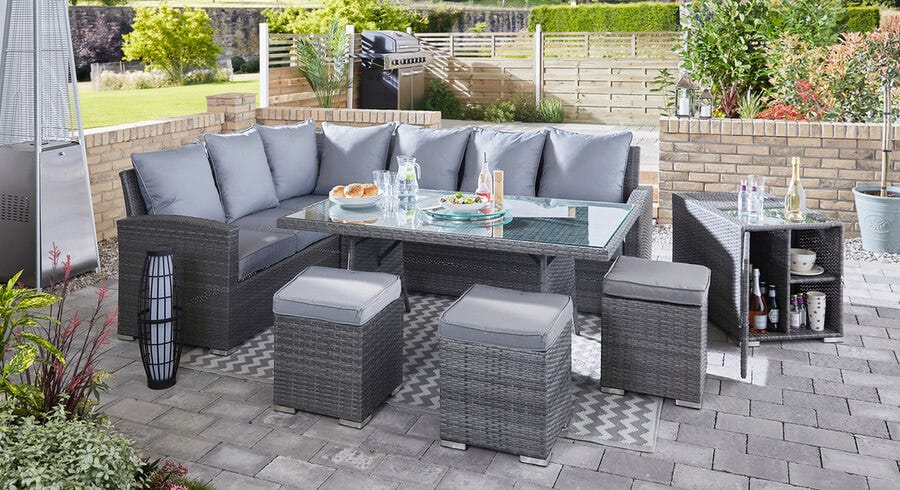Sensory Garden Ideas: Plants, Flowers and Features


Spending time in and making a sensory garden is heaps of fun, with the sights, sounds, smells and other stimuli heaven to the senses. With the help of our experts we’ve created a guide with everything you need to know, including what exactly a sensory garden is and how to create one. We’ve also listed some ideas for each sense, with recommendations for plants and flowers. Read on to find out more or skip to the section that’s most interesting to you!
What Is a Sensory Garden?
Whether they’re for the young or old, abled or disabled, sensory gardens are enjoyable for everyone, no matter what category they fall into. Generally created for children, people with autism and those with disabilities, they’re full of beautiful colours, sounds, tastes, textures and scents, making them magical havens for us all. They’re also useful for those with anxiety, depression or other mental health issues, with gardening for therapy now being suggested by experts.
How to Create a Sensory Garden
As well as stimulating all the senses with incredible plants and flowers, add some additional features to make it as interesting as possible. Pretty winding paths give sensory gardens a more enchanting look as they take you from one sensory spot to another; wind spinners and chimes add another dimension to the sights and sounds; and creative seating makes for a more immersive experience. With the right seats in the right spots, you can sit amongst colourful, sweet-smelling flowers or listen to the trickle of a water feature next to you – like a beautiful fountain or wildlife-laden pond.
As well as regular garden benches, you could opt for hanging chairs or hammocks so you can hover over the ground like the surrounding bees and butterflies, or create a seating cube or stepped seat from some wooden planks. Another option would be a weatherproof bean bag that you can sit in comfortably for hours and enjoy sinking into its depth.
Plants for Sensory Gardens
Native plants are ideal if you want your sensory garden to be as low maintenance as possible, as they’re more used to the environment, are less prone to disease and require less upkeep. If you’re willing to spend more time on maintenance, there are thousands of stunning exotic plants to include, with wondrous appearances, scents and textures. Some plants and flowers are even edible so it’s a great idea to include some of these and add an extra dimension to the stimuli.
Have a read below to discover specific flowers and plants for sensory gardens as well as other creative features to enhance the magic.


Smell
- Jasmine – This sweet smelling plant is incredibly common in women’s perfumes thanks to its beautiful musky fragrance, and the smell grows stronger in the evenings.
- Calendula – These annuals bloom throughout the growing season and have fragrant leaves and sweet-smelling flowers with a resin-like aroma.
- Curry plant – This gives off spicy aroma when it’s warm and sunny.
- Lemon balm – With a distinct scent of lemon, this plant looks a lot like mint and has small white flowers. To keep it smelling its best, let it grow naturally with no fertilizer.
- Wild garlic – This aromatic vegetable has a wonderful woodland smell that’ll transport you instantly to the forest.
- Lavender – This easy-to-grow evergreen shrub has a soothing, calming scent you can smell all year round.
- Rosemary, thyme and mint – These three herbs grow easily in British gardens and, like most herbs, the aromatic smell lingers on your fingers after touching them.
- Chamomile – This aromatic plant has a delicate and relaxing scent with flowers that are similar to daisies.


Sight
- Sunflowers – The strong, bright look of these striking flowers is a must for sensory gardens. Their height also makes them stand out boldly.
- Sweet pea – The gorgeous pinks and purple flowers of this vegetable make it well worth growing. Let them climb up canes to create a stunning display.
- Love-in-a-Mist – These beautifully delicate flowers are little bright blue stars in a ‘mist’ of fragile, crosshatched greenery. They’re perfect for balancing out stronger, bolder flowers.
- New Day Rose Stripe Gazanea – The striking stripes of red and cream make these flowers real showstoppers.
- Swiss Chard (Bright Lights) – These striking vegetables have brightly coloured stems and leaf veins in an array of yellows, pinks and oranges.
- Wind spinners – Bright and colourful, these pretty garden features spin in the wind, creating an effect that’s like an optical illusion.
- Garden mirrors – Not only do garden mirrors look beautiful, but they create the illusion of having more space or more plants to enjoy.
- Garden ornaments – Adorn your garden with pretty garden decorations, like metal animal ornaments, woodland wishing wells or hanging tree decorations.
- Solar lights – If you’ll be spending time in your sensory garden in the evenings, solar lights are essential. You can buy all sorts of different types, from colourful crackled globes to floral stakes and sparkling fairy lights.


Sound
- Bamboo (Phyllostachys) – This makes an ethereal whispering sound in the wind and also creates a beautiful ‘zen garden’ look when placed next to a dark painted fence.
- Greater quaking-grass – With long stems and graceful lantern-shaped heads, this pretty grass rustles in the wind.
- Bird baths and feeders – Bird care items will attract different species of birds, each with a different call. This not only creates extra sounds to enjoy, but adds an extra layer of fun for children especially, as they can learn and play games guessing which call belongs to which bird.
- Attract buzzing bees – Wildflowers are excellent pollinators, which means they’ll entice buzzing bees to visit. Buy either a ready-packaged mix of seeds, or try poppies or pollen- and nectar-rich plants like salvia, lavender (or French lavender) and rudbeckia.
- Wind chimes – A combination of wooden and metal wind chimes is ideal for sensory gardens as they’ll make different sounds. Metal wind chimes create a lighter, magical tinkling effect, while wooden ones have a more wholesome, natural sound.
- Water features – Who can resist the calming babble of running water as it cascades down a water feature? An ornamental feature makes an invaluable piece for a sensory garden – as do ponds that are bustling with wildlife.
- Attract crickets – The lovely chirping sounds crickets make is relaxing and therapeutic. Attract them to your garden with a patch of weeds and tall grasses, or piles of leaves and wood they can get lost and hide in.


Touch
- Moss – Soft to the touch, this is great when allowed to grow on walls and pots.
- Lamb’s ears – As the name suggests, this plant has leaves as soft as a lamb’s ears and is downy to the touch.
- Senecio Angel's Wings – These large silvery leaves are covered in down, making them soft and velvety.
- Silver sage – These soft leaves are also covered in a cotton-like down.
- Allium or Scadoxus – These lollipop-like plants have rigid stems with a sphere of tiny flowers on top (Allium flowers are purple while Scadoxus blooms are fiery red).
- Chenille – The fuzzy red blooms of the Chenille plant feel like furry catkins and are especially fun for children to touch.
- Jersusalem Sage – Unlike most leaves, those of Jerusalem Sage are soft and fuzzy.
- Mexican Feather Grass – The skinny blades of Mexican Feather Grass feel like hair, making it irresistable to run your fingers through.


Taste
- Sweet fruits – Blackberries, strawberries, raspberries and other fruits are perfect for adding a little burst of sweetness as you explore.
- Borage flowers – These blue five-pointed stars have a delicate cucumber flavour which is great for adding to cakes or salads. They can also be frozen in ice cubes for pretty summer drinks.
- Nasturtiums – The peppery taste of nasturtiums is quite fiery in the leaves, and a little gentler in the petals. These flowers also offer the handy benefit keeping pesky insects away from your crops if planted close by.
- Vegetables – Vegetables like lettuce, kale and tomatoes are ideal as you can pick and eat them easily as you make your way around the garden. Root vegetables like carrots and peppery radishes are great after a quick wash under an outdoor tap.
- Chives and their flowers – Members of the onion family, these pungent herbs have a light onion flavour and even have pretty purple edible flowers.
- Dill and its flowers – Dill is brilliant in salads or with fish. You can also eat its flowers, which have a light dill/aniseed taste, and offer the added benefit of attracting buzzing pollinators.
- Ginger and turmeric – These tasty root vegetables have an aromatic, spicy flavour and work well in teas as well as food dishes. Just be aware that turmeric might turn your fingers yellow if you handle it when peeled!
- Wild bergamot – This herb has a strong spicy scent and can be made into a delicious tea.
Feeling inspired? If you need some plants and gardenware, browse our huge garden range - you'll find live plants of all kinds, seeds, outdoor furniture and plenty more. Everything you need to create the sensory garden of your dreams.









